I have sometimes heard it said that if you could pull the plug out from the bottom of the sea, you could almost walk from Plymouth to Start Point over the remains of all the ships that have been wrecked along this part of the South Devon coast. To some this might seem an exaggeration until you realise that in 1804 for instance, on one day alone in Deadmans Bay, just yards from Plymouth’s famous Barbican, ten ships were driven ashore during fierce southerly gales. That kind of tally was by no means exceptional, and before Plymouth built its great breakwater, the port was fast becoming known as the graveyard of the British Navy.

But bad as it was, probably the most notorious stretch of water along this treacherous coastline was, and still is, the ten miles between Bolt Tail and Start Point, and only God knows just how many men have died, and how many ships have been smashed to pieces on its unforgiving shore. In one horrific incident near Bolt Tail in 1760, the Ramillies, a 90 gun ship of the line was swept into the cave that now bears her name, and in a few short minutes was pounded to tiny fragments. Over seven hundred people died trying to scramble out of the raging seas and up the sheer cliffs to safety. What is extraordinary however, is not so much the disaster aspect of the wrecks, ( if you have ever been off this part of the coast in a storm you will quickly appreciate that any mistakes are almost bound to lead to catastrophe) but the way certain areas seem to act as magnets for stricken vessels.
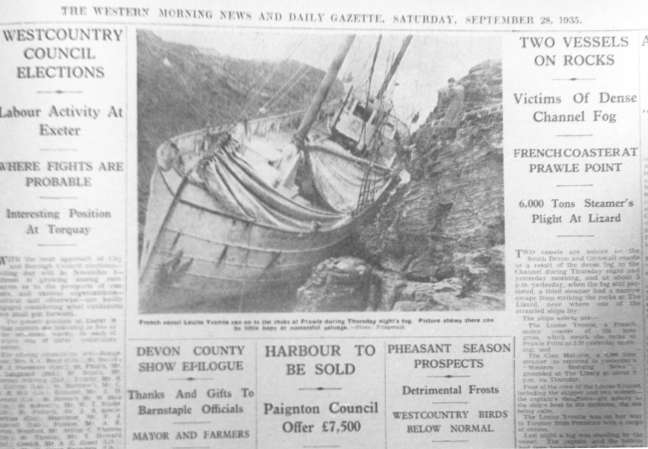
The Hamstone, mid way between Bolt Tail and Bolt Head for example collected three clipper ships and at least two steamers in just fifty years, and we will never know how many hit the surrounding area in vain efforts to take avoiding action. But there is one area along this coast that seems to have outstanding ability to act as a ship trap, and that is Prawle Point. On a sunny day this is the perfect spot for a picnic. The smooth sea gently laps around a rocky point, almost forming an island, and the steep cliffs gentle out to small slopes allowing easy access to the rock strewn beach. But come the storms all this calm is swept away with high waves breaking over the point and rushing savagely between the island and the shore creating a maelstrom of turbulent water and driving spray. Whilst many ships have struck the outside of Prawle Point, a significant number have managed to end up caught in between the jaws of the island and the mainland shore, and that’s where the real ship trap lies.
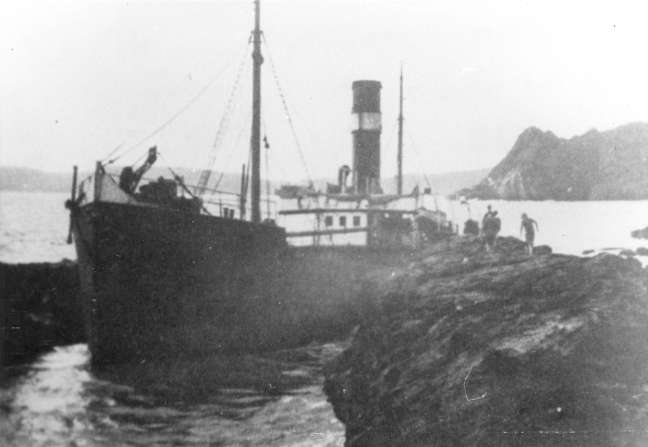
Most never escape, but in 1926 the Dutch steamer Betsy Anna had a stroke of good luck and proved to be a rare exception. She had stranded in thick fog on the morning of I7 August and ended wedged straight up between the island and the mainland. The weather however was very calm, and by the 3 October the Betsy Anna was towed off by the tug Trustee and beached near Salcombe for repairs. Nine days later she was towed towards Cowes, but as she was rounding Portland Bill her luck ran out, her tow parted and down she went.
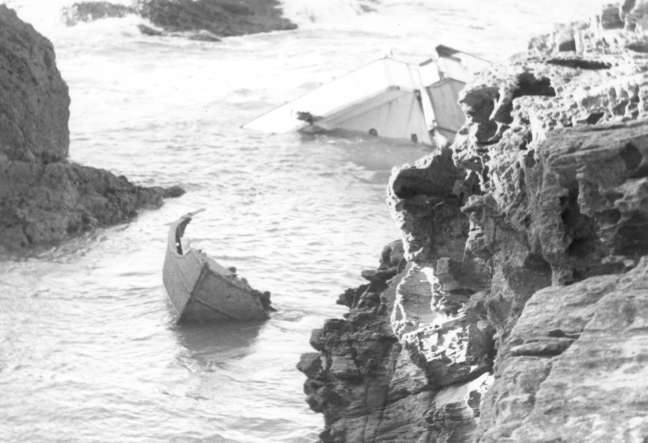
In more recent times Prawle Point has enticed two more ships into its island trap, and they unfortunately did not escape. Today their remains lie inextricably linked together, because although their wrecking occurred over forty years apart, they both managed to end up in exactly the same place, one on top of the other. On the morning of 29 September I935 the French vessel Louis Yvonne was outward bound from Penzance to Torquay with a cargo of onions, when she ran aground in dense fog in precisely the same place as the Betsy Anne nine years earlier. The crew of four and two women managed to jump off the boat onto the rocks, and safely made their way in the fog up to the nearby village. Come the dawn it was obvious that the boat was too well jammed to get her off and it was found that the bottom had been badly stove in when she grounded. The Louis Yvonne broke up over the next few months, and until fairly recently her bows could still be seen at low tide.
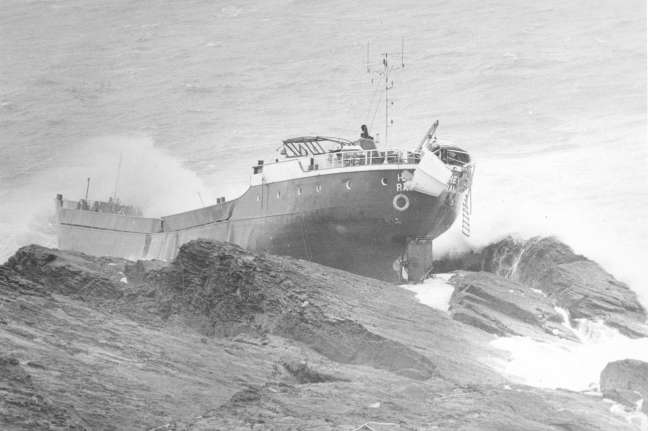
This state of affairs changed in 1979 when the 420 ton coaster Heye – P was overwhelmed by hurricane force winds on her way from Par in Cornwall to Velsen, West Germany, loaded with china clay. Drifting helplessly out of control, the Heye – P was pushed relentlessly towards Prawle Point. As huge waves broke over the ship, the crew began to realise that if the vessel struck the shore they would probably all perish. Suddenly out of the darkness came two bright beams of light from searchlights set up on the shore by the Coastguards. With their aid a rescue helicopter, its pilot nearly blinded by the huge sheets of spray whipped up by the gale force winds, managed to hover over the ship’s deck long enough to winch all three crew to safety. Minutes after the last man was plucked from the deck the ship struck the rocks with such force that she immediately broke her back, and very quickly became a total loss.
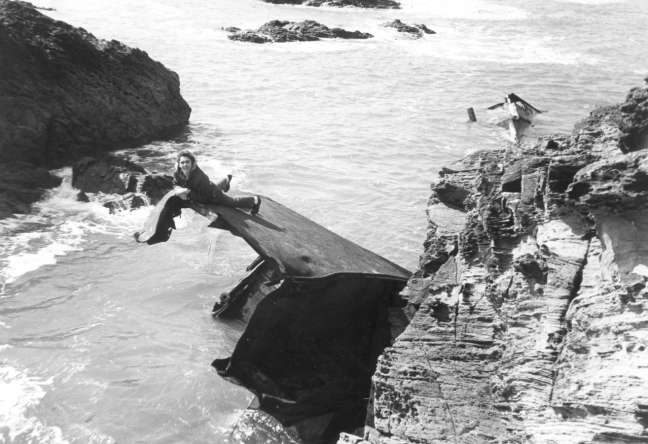
Today the remains of the Heye – P and the Louis Yvonne are easy to find, as both went aground almost directly underneath the coastguard station. Parts of the bows can be seen even at high tide, and some of the stern becomes visible at low tide. Almost completely hemmed in by rocks, the Heye – P and the remains of the Louis Yvonne lies in about thirty feet of water on a very rocky bottom. The bows of the Heye – P which are now on top of the Louis Yvonne point towards her stern, and lie on their side against one wall of a narrow gorge. The tide rip through this gorge can be extremely strong aid makes safe diving on the bows only possible at low tide. The wrecks are of course well broken up, and the debris of railings, old fire extinguishers, cable drums, winches, and broken iron plate litter the whole area. The stern section of the Heye – P lies with its rear end imprisoned between huge rocks, with its deck canted over at an angle of some forty-five degrees. The area abounds with rock overhangs and you have to be extremely careful, as it is very easy to swim in underneath these without noticing. Any tendency towards the surface can result in a very sore head.
I am extremely grateful to Peter Barc for the following information. He is now Captain of the Pat-M working in Cassablanca, but remembers the Heye-P at the start of his career.

The Heye-P is the most favourite ship I ever sailed on. I joined her in late 1969 at the age of 15 and she was partly owned by her Captain, Herman Kampen and his father in law Harald Diekhoff. They both lived in the small town in Ostrhauderfehn in Friesland Germany, and the mate onboard was Herman Kampens brother, who to this day lives in Norwich. We had a crew of four and the other sailor was a German called Stefan, who whilst on the Heye-P married a local girl in Ipswich, and is still there to this day, I am still in contact with him these days also.

Capt Herman Kampen is now retired. In those days with Heye -P we ran a ten day libner service, I still remember clearly having to lash down the tractors on deck from Ipswich to Paris, I left her after about being on her for 4 years and joined the sister ship “Warfleth” who also sank in the Thames estuary. A few years after I left her (Heye-P) she got sold to a British company but I can’t remember the name, but I do remember the lady that purchased her, Heather Chaplain from Kent if I remember right and I don’t think she owned Heye-P long before that fateful night off Prawle Point. Luckily nobody got hurt, and I must admit when I drove from Exmouth to Bolt Head and saw my first ship on the rocks, and the debris floating around, it did feel surreal, a very sad and emotional time as I stood and stared at her lifting and banging on the swell. I am very grateful to Andy Cory for this first hand account, and also for the great photos.
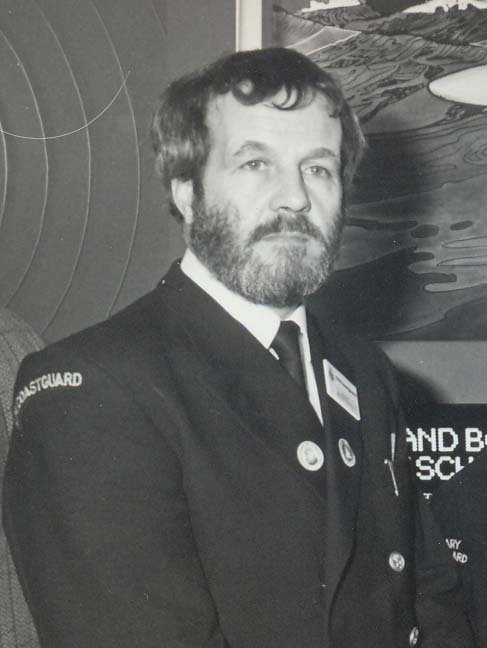
I became officer in charge of H.M. Coastguard Prawle, South Devon in November 1978 and witnessed the ‘worst winter in living memory’ being snowed in for over a week. One winters night in January 1979 the auxiliary Coastguard ( Bob Page a local dive boat skipper ) on watch at Prawle Point Coastguard station sighted a vessel approaching from the west and heading straight for the rocks at the point. After alerting me to scramble the Landrover mobile rescue unit, staff on watch continued attempts to warn the vessel off ( radio, signal lights and rockets ). At the same time from the deployed Landrover nearer to the vessel’s actual position, I fired several rockets directly over the vessel. None of these combined actions served to alert any of the crew and it ran ashore on the rocks directly below the Prawle Point Coastguard Station around 2230.

All attempts to rescue the three crew by lifeboat, and breeches buoy by the Prawle Coastguard rescue team were unsuccessful due to the storm force SW winds and mountainous seas. Positioned on top of the cliffs with my Coastguard rescue teams, sheltering behind rocks, I co-ordinated a Naval Rescue Helicopter from RNAS Culdrose, who eventually effected a heroic rescue of all three crew members despite being engulfed in dense sea spray during one attempt. In all my twenty plus years as a Coastguard Officer, this remains the most skilful and impressive helicopter operation I have ever witnessed.
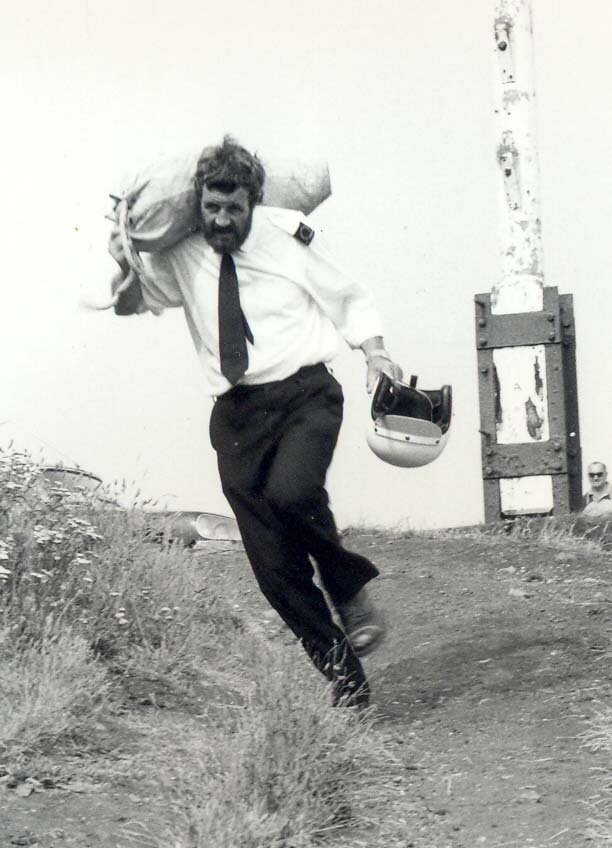

Note:- the MV Heye-P was carrying a cargo of china clay from Par in Cornwall to Holland. It appeared that the crewman on watch may have fallen asleep at the wheel and the Skipper and other crewmen were only awakened as the vessel hit the rocks. The bell was recovered from the wreck by local Coastguard Officers some days later. The bell was brand new for this trip and the owner Heather Mitchell had not had time to get it engraved but donated it to the Coastguard Station Officer at the time as a memento of the rescue.

Other wrecks to be found around Prawle Point include the Dutch East Indiaman De Boot wrecked in 1738, homeward bound from Batavia. Her cargo consisted of Ming porcelain packed into tea chests full of loose tea (good idea that) and boxes of uncut diamonds. The whole cargo back then was worth ?250 000, an absolute fortune, and extensive salvage was carried out. The ship eventually was smashed to pieces, but even today you can turn up fragments of blue and white porcelain, and apparently a six-foot iron cannon is to be found lurking in the gullies around Gull Rock although I have not seen it so far. What I have seen however are concreted cannon balls in amongst the wreckage of the Heye- P and Louis Yvonne, and they probably come from the wreck of H.M.S. Crocodile a 24-gun frigate on her way home from India. She hit Prawle Point in thick fog on the morning of May 9, 1784, and although she became a total loss all her 170 officers and men managed to escape without loss.
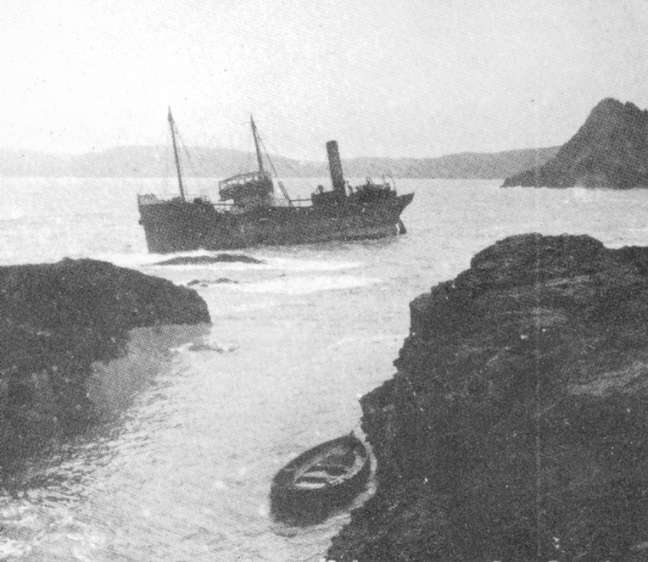
In September 1930 the steamer Ida on passage from Cardiff to Portsmouth with a cargo of coal, ran ashore just inside Prawle Point in thick fog. The Coast guards saved the crew of twelve and the ship lay broadside to the rocks until the October gales broke her into and she slipped into deeper water. However bits of her boiler and prop shaft can be seen in less that thirty feet if you can sort out what belongs to which wreck.

My favourite shipwreck is that of the Greek steamer Maria. She ran onto the Langler Rocks just to the west side of Prawle in thick fog on June 27 1892. The Salcombe lifeboat went out to help, but the crew, fed up with waiting rowed themselves ashore in the ships boat. The Maria had a very short life. She was launched in Sunderland in May 1891 and declared a total loss on July 19 1892. She is my favourite because I can’t find the main body of the wreck just the bits that are smashed into the rocks in less than ten metres. On a sunny day masses of tiny bits of brass that are crudded into the rock sparkle like diamonds, and objects like half a porthole seem to grow out of the rock. Small fish dart in and out and the whole area is an absolute joy. Almost on top of the Maria is the wreckage of the Dimitrios (see side bar) and it is almost impossible to sort out the tangle of wreckage. But I will do it one day, and am quite content to take my time

stefan plack says
Hello. my name is stefan plack i was on the heye p when she was built in 1967 upto 1973 a very modern ship at that time But i wonder if there is any newspapers or press footage you could send me i used to have a black and white photo of her but over years i have lost it It would be very nice to something to remind me all those years ago thank you.
richard cox says
Hello Stefan,
You will find photographs of the HEYE P on the Coasters Remembered website http://www.coasters-remembered.com/vbulletin/index.php of which I am a member.Also,Peter Barc an ex crew member of the HEYE P is also a member of the site.
rgds.Rick
David Mills says
My Grandfather Percival Mills was a coastguard stationed at Prawle Point around 1921 when my father was born. He had arrived at the Prawle from Buncrana, Northern Ireland and from Prawle he moved to Port Dinorwic, North Wales either as a coastguard or as a customs officer. If anyone has information on the coastguards at Prawle Point I would like to hear from them.
Dieter says
Good morning to all Im looking to see if the prawle point where the Heye p german coaster is laying I was told that in 1979 when the crew were airlifted by an RAF seaking helicopter they had news footage and media crews there has anyone or newspaper companies who have footage of the heye p when she sadly ran aground A lovely modern ship of the late 60s and 70s
Petert Barc says
hi Dieter
Yes you are correct, Heye-p was an ultra modern ship in her day built in 1967, I joined her in 69 at the age of 15 and had many happy years on her with many youthfull memories, I was not on her when she grounded off Bolt Head but co-incedently i was close by on another ship in the port of Exmouth so i hired a car and drove to Bolt head to see her on the rocks, i think i got there aprox 2 days later and she had already broken but there was much debris floating around, it was very sad to see her in that state, if you need further info on the ship and family that owned her when she was german i would be happy to oblige..
Peter Barc
Petert Barc says
is the coastguard station above the wrecks still manned ???? at bolt hd.
richard says
I would some media footage and or newspaper information on the heye p Yes its a very tragic loss
john pettifer says
Hi all Im hoping for some news of the Heye p footage with the local and media film crew used when this lovely ship hit the rocks As i work in the film and tv i ve been told its been located so watch this space in due course as i ll have news of where to obtain this footage
Andy Cory says
Peter,
I was the Coastguard Station OFficer in charge of the rescue of crew from the HEYE P and have been trying to find my lost photos when I came upon your site. Whilst your story of the demise is generally correct in principle, should you want to update it more accurately by all means contact me. After 20+ years in HM Coastuard that helicopter rescue was the most heroic and amazing I had ever witneseed.
Andy Cory
Peter Yohanson Von Barginson says
@Peter Barc, She grounded of Prawle point not bolt head, the two points are ove 5 mile apart!
My Uncle is a ship broker with Rs Plateau and he had just taken charge of the Heye P when it grounded on Prawle. The ironic thing is I live in Salcombe which is a few milles inland from Prawle and I saw it in the morning while out fishing. I rang him when I got back and he told me rather sheepishly that it was his. He said It was a brilliant ship which did not deserve the pedestal of Prawle Point.
Mick Perring says
Hi,
My Mother (Patricia NURSE) once lived at the Coastguard cottages when her Father was the coastguard sometime during the end of the war.
My Grandfather (Thomas PERRING) born in 1901 lived in nearby Hope, living in the house which he built. It was adjacent to the then Hotel Grandview. He named his house Homelea.
Mick
Submerged Comment says
Submitted on 2013/10/01 at 12:10 pm
Lee Korver (lkorver@live.co.uk) wrote:
Hello. I’m trying to contact Rick Cox from Costers Remembered. I am the son of a Dutch merchat navy sea captain. I think he may have some information / /pictures of ships my father was captain on.
Heather Chaplin says
If anyone wants any more information regarding the Heye-P , I’d be happy to help if I can. I bought her from Herman Kampen and was owner at time of her being wrecked.
Heather Chaplin says
To set the record right :-
Heye-P was on voyage to Holland, I believe it was Renkum, not Germany.
There was a following wind but initially not severe, although after grounding the wind force did increase considerably.
She had sailed from Par with only three crew which although not illegal for this size vessel at the time, is highly inadvisable as it puts undue stress on the crew in order to maintain the legal requirement of maintaining two on watch. As owner and manager, responsible for crewing, I was not informed by the relief Master or agents in Par that a crew member had left the ship and that they therefore needed additional crew before sailing. I was not made aware that they sailed short handed.
The mate was on watch with the deckhand and he told him to turn in saying that he’d call him if he was needed, the Master, who was off watch and turned in, was not consulted about this.
It was not known as to what time or position the mate left the wheelhouse to go down to check the engine room, typically done about every 2 hours, but it was a clear run with Eddystone light astern and Start Point light held on the Port Bow, about force 5 with a following sea. He set the autopilot and went down below.
The mate related that after returning from the engine room he had stayed below to make a cup of tea before returning to the bridge.
When he returned to the bridge he realised that the ship was very close to the rocks and switched the steering onto hand and tried to steer her off hard to starboard. When the ship was inspected by the Coastguards the rudder was hard over. However, it was also noted on inspection that the autopilot had been set incorrectly and had, since the mate left the wheelhouse to go to the engine room, been set to the north (Prawle Point) instead of the course to the south to keep her well clear of Start Point.
The Coastguard, Andy Cory, in the then manned Prawle Point C.G. Station had noted earlier that a small ship was heading as if to Salcombe Bay and presumed at first that she was heading into Salcome or just off maybe with engine or other issues. But as soon as he saw her standing on for the course towards Prawle Point, he and his colleagues realised that there was something very wrong, tried calling her on the radio but no response so called the pub in Prawle village to set off the maroons over the vessel this was from an elevation higher than the C.G.Stn. The Coast Guard set off the whole stock of pyrotechnics from their station over the ship – but still no response from the ship. They could by then ascertain that there was no one in the wheelhouse. If even the most inexperience deckhand had been there as the second on watch he would have seen the flares and lights much earlier and call the mate up and as she was fitted with a Becker Rudder, they may well have had a chance to steer off in spite of the following sea.
The Coast Guard then called both Salcombe lifeboat and RAF Culdrose.
The lifeboat could not get close to the ship which had now grounded, almost beam on as the mate had at the last minute put the helm hard to starboard but too late. The wind and sea conditions had by this time worsened considerably.
The lifeboat stood by and shone lights onto the Heye P for the helicopter. By the time the crew were lifted off the top half of the wheelhouse had been broken in by the wind and waves. All three crew were lifted off, however it was reported that none of them were wearing a lifejacket.
This shocking incident and the loss of a wonderful little ship was the result of human errors, one after the other, not due initially to weather or any mechanical failure.
It is with thanks to the great courage and efforts of the Coast Guard Andy Cory and his colleagues, the lifeboat and helicopter crews that these three lives were saved.
Alan Mitchell says
It is now 2021, My name is Alan Mitchell, Heather Chaplin was my wife and at the time we were in Kent having a short break from the ship, having put a relief crew on with a captain that had been highly recommended to us. I can still remember the shock of being woken up in the middle of the night to be told about the ship being wrecked and our frantic drive to Cornwall. I am pleased to read what Heather wrote, her account is factual and accurate, I remember our meeting with Andy Cory – a very sad occasion.
We went on and purchased her sister ship, the Anton Held, that we ran before going full time onto the Dutch waterways with a Dutch barge.
Steffan says
RE: Heye p.
My father harald janzen.was on the heye p in 1967 in the shipyard just before she went to sea.My father said stefan plack joined the heye p in 1969 just before harald left and never got on much stefan whilst serving on the ship.
So stefan it was 69 when you went aboard the heye p aged 15.These days my father is happly married to a lovely lady my mother.Harald doesn’t want or talk about the past as me his son we are restoring an 1961 MG Midget back original state.We both keep in touch with peter barc who visited us twice with his wife.Apart from that my parents celebrated their 52nd wedding anniversary early this year…